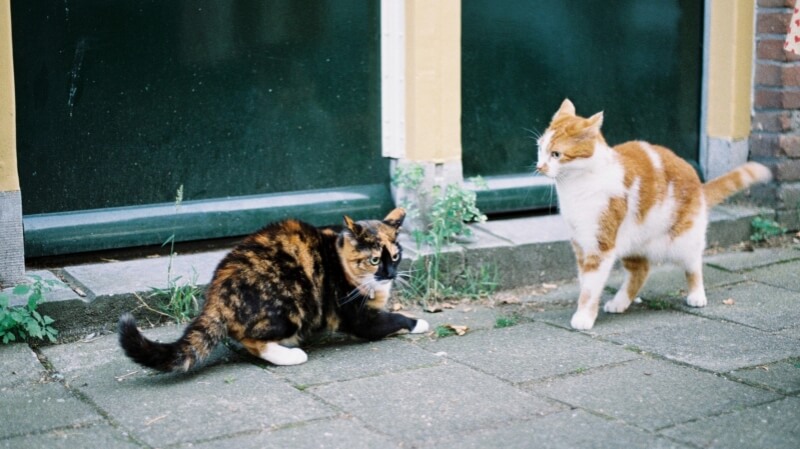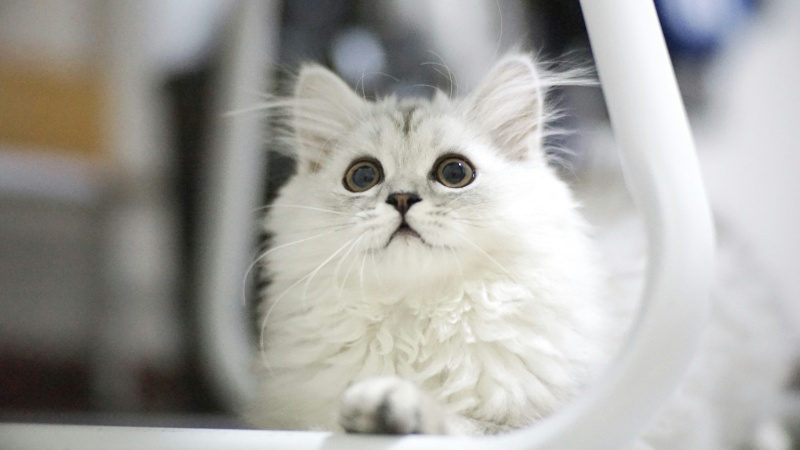
How To Craft A Cozy Cat Vest From Fabric Strips
Have you ever seen your feline friend lounging around and thought, “What could possibly make this picture more adorable?” The answer is simple: a cat

In a home with multiple cats, harmony among them is ideal. Yet, it can be challenging to discern when their interactions shift from harmless to harmful.
The dilemma of cats fighting or playing becomes apparent when they engage in chasing, hissing, and pouncing activities.
At such times, you might ponder, “Is this playful or aggressive behavior?” To clarify this, pay attention to their ear and tail positions, as well as their general conduct towards each other beyond these moments.
Gestures are highly revealing. Activities such as jumping, chasing, and occasional hissing can be part of both play and conflict. Playful skirmishes might seem slightly rough. Your cats could engage in gentle “play biting” without causing harm.
In playful tussles, cats often alternate roles, with one at the bottom of the pile, then switching. They may pause occasionally for a break. If your cats seem relaxed or their ears are upright, they’re probably playing.
Conversely, if your cats lay their ears flat, pull them back, or fluff up their fur or tails, it indicates a real fight. Defensive stances, puffy fur, leaning away, hissing, and showing teeth are signs of threat, not enjoyment.
Persistently chasing a weary cat leading it to hide is a troubling sign. Causing actual injury is a clear indication that the situation has escalated dangerously.
Observing your cats’ behavior when they’re not engaged in play can provide insights into the nature of their interactions. If they groom each other, snuggle together, or coexist peacefully, it’s a good sign that their encounters are playful.
On the other hand, if cats seem stressed or intimidated by each other, it could indicate that their interactions are more about fighting than playing. In such cases, they might avoid one another, or react with hissing or growling when in close proximity.
Accidental contact could cause them to startle or react negatively. You might also notice signs of distress in one or both cats, including hiding, eliminating outside the litter box, marking territories inappropriately, increased destructiveness, or even aggression towards you. These behaviors can be indicators of underlying tension and conflict.
If you’re dealing with cats that seem to be fighting, don’t lose hope—you have ways to help. Initially, distract your cats with toys like a feather wand during tense moments. (Important: never intervene physically between fighting cats or attempt to separate them by hand.)
Consider using Comfort Zone Multi-Cat Diffusers in the rooms your cats frequent. These diffusers release harmless, drug-free vapors that mimic cat pheromones, conveying a message of safety and tranquility.
In tense situations, these diffusers can create a more serene environment. Additionally, employing the BreakAway Comfort Zone Calming Collar on each cat can provide continuous calming effects.
Often, cats lacking sufficient stimulation may direct their pent-up energy towards each other.
Create an engaging environment with window perches, cat condos, and trees in various rooms, allowing them to establish their own spaces. Offer them interactive toys and plenty of playtime.
Clicker training can also be beneficial for mental stimulation. If you’re adventurous, consider taking your cats for supervised walks in the backyard using a harness and leash.
When efforts to divert their attention fail and other activities don’t make a difference, it may be necessary to reintroduce your cats as though they’re meeting for the first time.
This process entails keeping them in separate areas, exchanging their scents, and feeding them on either side of a closed door.
Once they remain calm while sensing each other’s presence, progress to feeding them on opposite sides of a screen or gate. Following this, allow brief, monitored interactions. Gradually, they’ll understand that the other cat is not a threat.
Determining the boundary between play and combat can be challenging. If you observe signs of conflict, increased supervision and playtime might be beneficial.
It’s always advisable to consult a cat behaviorist or your veterinarian if you’re uncertain about the next steps. With appropriate measures, most cats can relearn to coexist peacefully.
FAQ: How to Differentiate Between Playful and Aggressive Vocalizations in Cats?
Answer: Understanding the nuances of cat vocalizations is crucial. While both playful and aggressive interactions may involve vocal sounds, the tone and frequency can be telling.
Aggressive vocalizations are often louder, more prolonged, and may include growls or shrieks, whereas playful sounds tend to be softer and more chirp-like.
FAQ: What Role Does Age Play in How Cats Interact?
Answer: Age can significantly impact how cats interact. Younger cats are generally more energetic and may engage in rougher play, which can be mistaken for fighting.
Older cats, on the other hand, might have lower tolerance levels and can quickly escalate from play to aggression. Understanding your cats’ age-related behaviors is important in assessing their interactions.
FAQ: How Can I Safely Intervene If My Cats Are Fighting?
Answer: If you suspect a fight, it’s important to intervene safely. Avoid using your hands to separate them, as this can lead to injury. Instead, try making a loud noise to distract them, or use a barrier like a piece of cardboard to gently separate them.
In some situations, employing a tactical cat harness can be effective, especially if one cat needs to be safely removed from the area without direct physical contact.
FAQ: Can Changes in the Home Environment Cause Behavior Changes in Cats?
Answer: Yes, changes in the home environment, such as moving furniture, introducing new pets or family members, or even a change in routine, can cause stress in cats. This stress can manifest in altered behaviors, including increased aggression or retreat into more solitary play.
FAQ: Are There Specific Signs of Stress or Anxiety in Cats That I Should Look Out For?
Answer: Signs of stress or anxiety in cats can include excessive grooming, changes in eating or sleeping habits, avoidance behavior, and uncharacteristic aggression.
These signs might indicate that their interactions are more stress-induced than playful, and may require further attention or a consultation with a vet or behaviorist.


Have you ever seen your feline friend lounging around and thought, “What could possibly make this picture more adorable?” The answer is simple: a cat

The moment you consider a dog hunting vest for your adventurous companion, you’re stepping into a world where safety meets functionality. This vest is not

The concept of a dog cooling vest is a game-changer for pet owners looking to enhance their dog’s comfort during those relentless summer days. Imagine

When you first consider crafting a tactical dog vest, it’s not just about embarking on a fun DIY project; it’s about ensuring your furry companion’s

Have you ever seen your feline friend lounging around and thought, “What could possibly make this picture more adorable?” The answer is simple: a cat

The moment you consider a dog hunting vest for your adventurous companion, you’re stepping into a world where safety meets functionality. This vest is not

The concept of a dog cooling vest is a game-changer for pet owners looking to enhance their dog’s comfort during those relentless summer days. Imagine

When you first consider crafting a tactical dog vest, it’s not just about embarking on a fun DIY project; it’s about ensuring your furry companion’s
Secure and Empower, Walk Responsibly
Copyright © 2025pettacticalharness. All Rights Reserved.